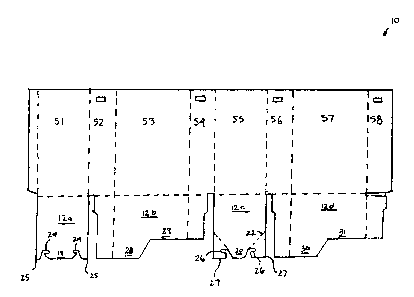Une partie des informations de ce site Web a été fournie par des sources externes. Le gouvernement du Canada n'assume aucune responsabilité concernant la précision, l'actualité ou la fiabilité des informations fournies par les sources externes. Les utilisateurs qui désirent employer cette information devraient consulter directement la source des informations. Le contenu fourni par les sources externes n'est pas assujetti aux exigences sur les langues officielles, la protection des renseignements personnels et l'accessibilité.
L'apparition de différences dans le texte et l'image des Revendications et de l'Abrégé dépend du moment auquel le document est publié. Les textes des Revendications et de l'Abrégé sont affichés :
| (12) Brevet: | (11) CA 2462249 |
|---|---|
| (54) Titre français: | SYSTEME DE VERROUILLAGE DE RABAT DE BOITE |
| (54) Titre anglais: | BOX FLAP LOCKING SYSTEM |
| Statut: | Périmé et au-delà du délai pour l’annulation |
| (51) Classification internationale des brevets (CIB): |
|
|---|---|
| (72) Inventeurs : |
|
| (73) Titulaires : |
|
| (71) Demandeurs : |
|
| (74) Agent: | MARKS & CLERK |
| (74) Co-agent: | |
| (45) Délivré: | 2009-06-23 |
| (22) Date de dépôt: | 2004-03-29 |
| (41) Mise à la disponibilité du public: | 2005-01-15 |
| Requête d'examen: | 2006-02-20 |
| Licence disponible: | S.O. |
| Cédé au domaine public: | S.O. |
| (25) Langue des documents déposés: | Anglais |
| Traité de coopération en matière de brevets (PCT): | Non |
|---|
| (30) Données de priorité de la demande: | |||||||||
|---|---|---|---|---|---|---|---|---|---|
|
L'invention, une boîte pliable à système de verrouillage de rabat de boîte comprenant un premier rabat ayant un rebord dans lequel une languette généralement trapézoïdale est découpée, la languette généralement trapézoïdale est délimitée par deux rainures vers l'intérieur; et un second rabat se verrouille dans le premier rabat, le second rabat comprend un rebord dans lequel une languette généralement trapézoïdale est découpée, la languette généralement trapézoïdale est délimitée par deux saillies vers l'extérieur.
The invention provides a foldable box design having a box flap locking system, comprising: a first flap having an edge with a generally trapezoidal shaped tab cut therein, wherein said generally trapezoidal shaped tab is defined by two inwardly projecting grooves; and a second flap that locks with the first flap, wherein the second flap includes an edge with a second generally trapezoidal shaped tab cut therein, and wherein said second generally trapezoidal shaped tab is defined by two outwardly projecting grooves.
Note : Les revendications sont présentées dans la langue officielle dans laquelle elles ont été soumises.
Note : Les descriptions sont présentées dans la langue officielle dans laquelle elles ont été soumises.

2024-08-01 : Dans le cadre de la transition vers les Brevets de nouvelle génération (BNG), la base de données sur les brevets canadiens (BDBC) contient désormais un Historique d'événement plus détaillé, qui reproduit le Journal des événements de notre nouvelle solution interne.
Veuillez noter que les événements débutant par « Inactive : » se réfèrent à des événements qui ne sont plus utilisés dans notre nouvelle solution interne.
Pour une meilleure compréhension de l'état de la demande ou brevet qui figure sur cette page, la rubrique Mise en garde , et les descriptions de Brevet , Historique d'événement , Taxes périodiques et Historique des paiements devraient être consultées.
| Description | Date |
|---|---|
| Le délai pour l'annulation est expiré | 2022-09-29 |
| Lettre envoyée | 2022-03-29 |
| Lettre envoyée | 2021-09-29 |
| Lettre envoyée | 2021-03-29 |
| Représentant commun nommé | 2019-10-30 |
| Représentant commun nommé | 2019-10-30 |
| Inactive : TME en retard traitée | 2017-04-03 |
| Lettre envoyée | 2017-03-29 |
| Accordé par délivrance | 2009-06-23 |
| Inactive : Page couverture publiée | 2009-06-22 |
| Préoctroi | 2009-03-06 |
| Inactive : Taxe finale reçue | 2009-03-06 |
| Un avis d'acceptation est envoyé | 2008-11-18 |
| Lettre envoyée | 2008-11-18 |
| Un avis d'acceptation est envoyé | 2008-11-18 |
| Inactive : Approuvée aux fins d'acceptation (AFA) | 2008-10-28 |
| Modification reçue - modification volontaire | 2007-12-11 |
| Inactive : Dem. de l'examinateur par.30(2) Règles | 2007-06-11 |
| Modification reçue - modification volontaire | 2006-08-21 |
| Lettre envoyée | 2006-03-09 |
| Exigences pour une requête d'examen - jugée conforme | 2006-02-20 |
| Toutes les exigences pour l'examen - jugée conforme | 2006-02-20 |
| Requête d'examen reçue | 2006-02-20 |
| Lettre envoyée | 2005-06-01 |
| Inactive : Correspondance - Transfert | 2005-03-23 |
| Demande publiée (accessible au public) | 2005-01-15 |
| Inactive : Page couverture publiée | 2005-01-14 |
| Inactive : Lettre officielle | 2004-08-31 |
| Inactive : Transfert individuel | 2004-07-27 |
| Inactive : Correspondance - Formalités | 2004-06-08 |
| Inactive : CIB en 1re position | 2004-05-16 |
| Inactive : CIB attribuée | 2004-05-16 |
| Inactive : Lettre de courtoisie - Preuve | 2004-05-04 |
| Inactive : Certificat de dépôt - Sans RE (Anglais) | 2004-04-28 |
| Exigences de dépôt - jugé conforme | 2004-04-28 |
| Demande reçue - nationale ordinaire | 2004-04-28 |
Il n'y a pas d'historique d'abandonnement
Le dernier paiement a été reçu le 2009-03-27
Avis : Si le paiement en totalité n'a pas été reçu au plus tard à la date indiquée, une taxe supplémentaire peut être imposée, soit une des taxes suivantes :
Veuillez vous référer à la page web des taxes sur les brevets de l'OPIC pour voir tous les montants actuels des taxes.
Les titulaires actuels et antérieures au dossier sont affichés en ordre alphabétique.
| Titulaires actuels au dossier |
|---|
| NORAMPAC SCHENECTADY, INC. |
| Titulaires antérieures au dossier |
|---|
| THOMAS WEST |